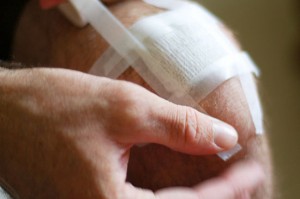 Quick thinking, confidence in your abilities and first aid know-how can make a big difference in emergency situations, especially if those situations involve someone important to you. Every second counts during emergencies as things can become serious fast. For example, wounds can result in heavy blood loss that might become fatal so it’s important to have some first aid training on what to do with open wounds.
Quick thinking, confidence in your abilities and first aid know-how can make a big difference in emergency situations, especially if those situations involve someone important to you. Every second counts during emergencies as things can become serious fast. For example, wounds can result in heavy blood loss that might become fatal so it’s important to have some first aid training on what to do with open wounds.
Steps for Closing a Wound
- Have a well-stocked First-Aid kit in different areas in your home and car. Always bring your first aid kit on family vacations or when going out for a play date with your children. First aid kits are affordable and can easily be bought at any pharmacy, but you can also make your own.
- Stop the wound’s bleeding as soon as possible. In the case of small cuts and scratches, the bleeding usually stops not long after the injury is sustained so the first thing to do should be to wash off the wound. Conversely, it’s critical to stop the bleeding of puncture or open wounds. In a typical first aid course, students are taught to gently apply a clean cloth to the wounded area and hold it until the bleeding stops. If blood flow is heavy or blood loss hasn’t been stopped, call 911 or other emergency numbers immediately.
- Once bleeding has stopped, clean the wounded area with cool and clean water. Remove any dirt or shrapnel from the wound and then run clean water over the area again to ensure the area is clean.
- Put antibiotic cream on the wound. A popular antibiotic cream is Neosporin but hydrogen peroxide, iodine or rubbing alcohol can also be used. However, rubbing alcohol and hydrogen peroxide stings and shouldn’t be applied immediately to any deep wound.
- Use a bandage to dress the wound properly. A band-aid can be used for smaller wounds while gauze and a large bandage that can be taped are often used for larger wounds.
- Make sure that bandages or dressings are changed often. Wounds should also be aired from time to time before re-dressing it with fresh antibiotics and a new bandage.
First Aid for Stab Wounds
It goes without saying that first aid for stab wounds is very different as it occurs in a very dangerous or volatile situation. You have to make sure that the scene is safe before helping a stabbing victim.
- Ensure your and the victim’s protection against infection by using disposable gloves. Putting plastic bags over the hands can also be an option. However, if there’s no other choice but to touch the victim bare-handed, make sure that your hands are really clean.
- Check the victim’s airway first, especially if the wound is close to the chest before carefully taking off the victim’s clothing so you can clearly see where the wound’s located.
- Never pull out the stabbing object as it might hasten blood loss or cause further injury to the victim.
- As with other wounds, stop the bleeding by pressing a clean cloth over the wound. For stab wounds that are bleeding profusely, apply pressure on the major artery leading to the wounded area and if possible, position the wound above the heart’s level.
It’s important that you remain with the victim while waiting for an EMT or any personnel with first aid certification to arrive.